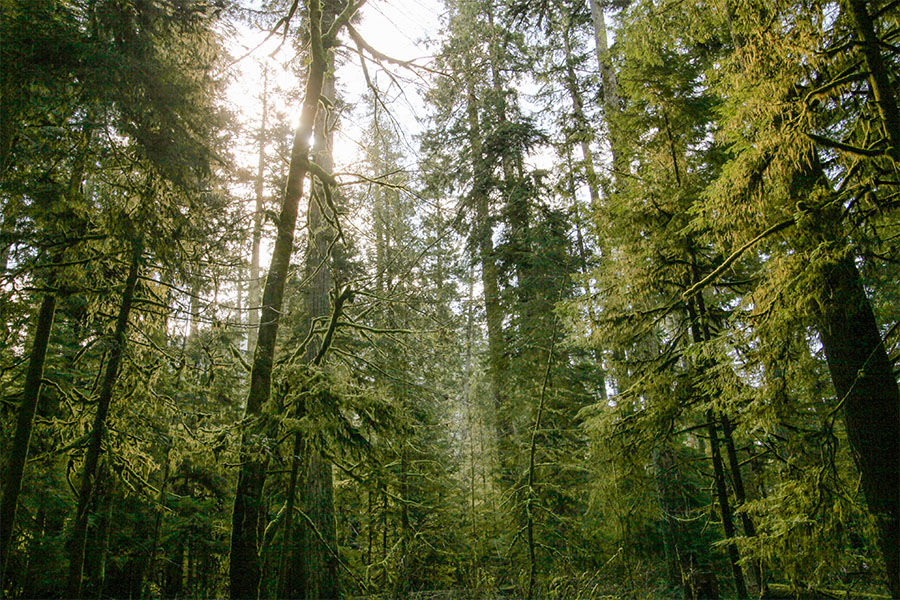- The Hidden Life of Trees: What They Feel, How They Communicate — Discoveries from a Secret World
- Greystone Books and David Suzuki Institute (2016)
Nearly a half-century ago, scientists discovered something remarkable happening between acacia trees on the African savannah. The trees were known to produce a bad-tasting chemical in their leaves when set upon by hungry giraffes that would eventually drive them away. But what the researchers realized, clued in by the puzzling grazing behaviours of giraffes who would move to other trees to browse, but only distant ones upwind, was that the trees also emitted chemical scents — warning signals — that could be picked up by nearby acacias. These pheromones, carried by the wind, gave trees in the vicinity a chance to mount their defences before the giraffes could strike.
We know now that tree communication goes way, way beyond scents on the breeze. Trees in a mature and healthy forest are connected, literally, by vast fungal networks (the largest known one, in Eastern Oregon, covers nearly 2,500 acres that are inextricably linked to trees’ root systems.
This “wood wide web” allows trees to share food, water and information. Trees are all connected, and the extent to which they grow strong and healthy depends to a great degree on how much they can depend on one another. In other words, it takes a forest.
This is one of the big takeaways from Peter Wohlleben's new book, The Hidden Life of Trees. Wohlleben started his career in the German forestry service, and spent nearly two decades wandering through the woods assessing trees for their suitability for the lumber mill. Eventually, the more he learned about forest ecology, the less this perspective made sense. (He now runs an “environmentally friendly woodland,” works on forest restoration projects in Europe and writes books about trees.)
He’s not a beautiful writer; the book takes on a dull cadence of textbook or manual at times and incredible factoids can get buried in densely packed paragraphs.
(Did you know if you put a stethoscope against a tree trunk in the spring, it’s possible to hear sap shooting upwards towards the leaves? Or that tree barks wrinkles as its gets old, just like our skin? Or that, during a heavy storm, a tree can suck an additional 200 gallons of water down into its roots?)
But all of his years hanging out with trees have given him a deep appreciation for them that shines through in a charming way. Wohlleben uses language that seems more fitting for anthropologist than an ecologist to portray the forest as a community, made up of individuals.
For example, he describes realizing how misguided the forestry sector's methods of thinning trees really is, given that “mothers” shade their “children” with big bushy crowns most of their lives to ensure slow growth. Instead of reaching up for the sun, the tree grows out through branches and down through the roots. This kind of “proper upbringing” ultimately results in a more stable and long-lasting tree.
Or, consider how he frames the process of a deciduous tree preparing for winter. If it drops its leaves too early, it loses valuable photosynthesizing and food production time. If it drops its leaves too late, it risks losing entire branches, made more vulnerable to high winds when in full leaf, in October and November storms. The problem of when to drop leaves is a “decision” that individual trees make differently. And considering that different trees very close to each other make the decision at various times, “the timing of the leaf drop, it seems, really is question of character.”
And why not speak of trees in this way?
Suzanne Simard, the University of British Columbia forest ecologist who coined the term “wood wide web” (and who writes a note included in the end of this book) has called attention to the very brain-like function of this web, which uses chemical messages, electrical impulses, and even sound signals to communicate.
The question of whether or not trees could be considered to have brains, a repository of intelligence, memory, or even emotion is a controversial one among researchers. “Among other things, they get worked up about... how this threatens to blur the boundary between plants and animals. And so what?” Wohlleben asks. “Sometimes I suspect if we would pay more attention to trees and other vegetation if we could establish beyond a doubt just how similar they are in many ways to animals.”
Wohlleben is able to articulate why, without a doubt, we need trees. He details their “almost inextricable” relationship with water and air. Trees store water deep in underground pockets for decades for instance, which can be drawn on during periods of drought. Coastal forests act as cloud factories, pushing moisture-laden air further into dry interiors. Trees don’t just breathe carbon dioxide, in the lungs analogy most of us learned as children, but filter out and store it deep in the earth in their extensive root systems.
And this is not to mention the role that trees serve in terms of forest infrastructure. Wohlleben describes them as “motherships of biodiversity.” When a tree is wounded, allowing access to its softer, spongier innards, woodpeckers will move in first, hacking away to construct “rooms” within the tree trunk. As the cavity widens due to decay, larger and larger animals move in — raccoons, squirrels, eventually owls. In one particularly gruesome experiment a researcher sprayed the oldest and largest tree in the Bavarian national forest with an insecticide and 2,041 animals from 257 different species tumbled out dead.
It's easy, at least for me, to read these things and feel dismay almost instantly darken my wonder at each new and fascinating fact. The United Nations estimates that in the past quarter-century, 129 million hectares of forest have disappeared, an area the size of South Africa. Forests — managers of fresh water and the original carbon storage technology — are being destroyed when we need them most.
Wohlleben, however, does not. He writes, perhaps somewhat naively, that “I am not anxious when I think about the future of our forests,” and this is largely due to his deep understanding of how adaptable and how long-lived trees are. A 40-year-old beech, in tree years, is but a baby. A 200-year-old Douglas fir is barely out of its teens. An ancient spruce in Sweden was carbon dated at 9,550 years old. Tree species have been coming to grips with new threats forever, he points out, and a “five-hundred-year-old tree has surely had a few surprises in its life.”
But his optimism comes with a caveat; only forests allowed to evolved naturally will survive. If we can end the “plantation” approach to resource management and allow trees to live out their societal duties, we’ll all be better off. ![]()
Read more: Environment
















Tyee Commenting Guidelines
Comments that violate guidelines risk being deleted, and violations may result in a temporary or permanent user ban. Maintain the spirit of good conversation to stay in the discussion.
*Please note The Tyee is not a forum for spreading misinformation about COVID-19, denying its existence or minimizing its risk to public health.
Do:
Do not: